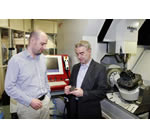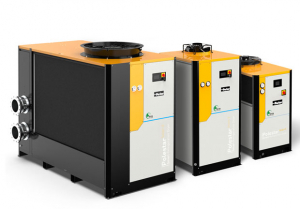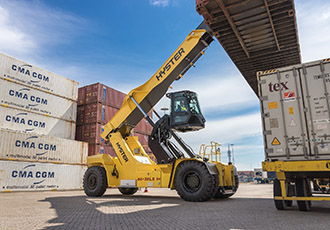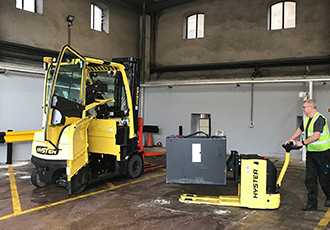Irish Manufacturer Expands High-speed Machining With 5-axis Acquisitions
7th November 2011
Source:
Hurco Europe Ltd

As far back as 1998, Smithstown Light Engineering in Shannon, Co Clare, was in the vanguard of high-speed metalcutting, having installed the 12th machining centre ever built by the German firm, Roeders. The 3-axis, vertical-spindle machine has been in continual operation ever since and its 44,000 rpm spindle is still the fastest in the Irish manufacturer's factory.
Thirteen years ago, Smithstown produced mainly plastic injection moulds for the electronics industry, but most of that business has drifted away to the Far East. So founder Brian King and his son, Gerard, the current managing director, have moved into the manufacture of moulds for producing medical filters and check valves for intravenous drips are a particular specialism.
Machining of surgical instruments from a variety of metals forms the larger part of Smithtown's work, however, which together with the moulds means that 90 per cent of the company's turnover is derived from the medical sector. Aerospace contracts account for most of the remainder.
Brian King commented, We evaluated equipment from all the big manufacturers of machining centres at the Hannover EMO in 1997. We opted for Roeders due to the in-depth understanding of high-speed machining shown by the company's CEO, Juergen Roeders. He was clearly in the forefront of the technology and demonstrably still is.
Gerard King added, Those early machine designs were boxy but remain very accurate today. We have had four software upgrades since we bought the 3-axis model and the latent accuracy of the machine has allowed us to extract better performance every time.
The latest upgrade has been particularly beneficial in terms of increased accuracy of machining. It alters the way the NC code is read and how that translates into X,Y,Z movements, and also enhances laser measurement of the tool after it has been cleaned by compressed air.
Mainly graphite and some copper electrodes for spark erosion machines were formerly manufactured by Smithstown in multiple set-ups on older CNC mills with 6,000 rpm spindles. The relatively low speed dictated that milling cutters could not be smaller than 4 mm diameter, otherwise the minimum surface cutting speed for efficient machining would not be reached. Typical tolerance held was ±20 microns.
Problematically, the trend was towards increasingly accurate moulds with ever finer detail. The move to the Roeders machining centre provided the solution, as its high spindle speed means that cutters down to 0.2 mm diameter can be used while the machine's build quality and rigidity allow tolerances of ±5 microns to be held easily.
Machining of some cores and cavities directly on the Roeders involves cutting some very hard steels, including Stavax at 52-54 HRC and D2 up to 60-62 HRC. Good results are achieved in all materials.
Brian King recalled, When previously machining electrodes on the CNC mills, almost inevitably a slight burr was created that had to be ground away; and it was impossible to get sharp corners.
As soon as we installed the Roeders, the problems disappeared. Corners are always spot on. Back in 1998, accuracy like that was unheard of.
Smithstown was one of the first manufacturers to move largely to a paperless working environment with the installation of Unigraphics (now NX) 3D solid modelling CADCAM seats. The same data is used on two Zeiss co-ordinate measuring machines to check the increasingly tight tolerances.
Unigraphics software specialists from Siemens worked with Juergen Roeders and his team in Germany to develop the first versions of non-uniform rational B-splines (NURBS) to smooth complex 3D cutting cycles and raise contouring speed, accuracy and surface finish. Smithstown was closely involved in helping to improve the technology in the early days and still keeps in close contact with the factory in Soltau, Northern Germany.
Entry into 5-axis machining
Throughout the last decade, it became increasingly apparent that 5-axis machining could reduce the number of set-ups and allow more complex components to be produced. Brian King kept a close watch on the technology but thought that the accuracy of fully interpolative 5-axis metalcutting was not good enough earlier on, so held off investing in the technology.
By 2008 that had changed, and after experiencing difficulty with another make of 5-axis vertical machining centre, Smithstown installed a Roeders RXP 600 DSH 5-axis machine in July 2009.
Supplied through sole agent Hurco Europe in High Wycombe, UK, and local Irish representative, Michael Gannon, the machine has a ±115 degree trunnion carrying a rotary table to provide the B and C axes, both of which use linear motor technology. The 36,000 rpm, HSK E50 spindle delivers 17 kW of power and feed rates are up to 60 m/min thanks to the linear motor in X, ballscrew drives being retained for Y
and Z.
One of the drivers for the latest investment was an increase in orders for larger quantities of aluminium moulds for manufacturing complicated designs of femoral and tibial parts. Typically, 150 moulds per year are produced and each requires 150 to 250 hours' machining, depending on complexity.
A second, identical 5-axis machining centre was installed in January 2011 and has been positioned alongside the first in a temperature controlled room in Shannon with an eye to introducing robotic load/unload. Such an automated production cell would not be cost effective for mould manufacture, as each is different, but if a contract was won for machining implants in volume, for example, automation could be justified financially.
Machining of surgical instruments from a variety of metals forms the larger part of Smithtown's work, however, which together with the moulds means that 90 per cent of the company's turnover is derived from the medical sector. Aerospace contracts account for most of the remainder.
Brian King commented, We evaluated equipment from all the big manufacturers of machining centres at the Hannover EMO in 1997. We opted for Roeders due to the in-depth understanding of high-speed machining shown by the company's CEO, Juergen Roeders. He was clearly in the forefront of the technology and demonstrably still is.
Gerard King added, Those early machine designs were boxy but remain very accurate today. We have had four software upgrades since we bought the 3-axis model and the latent accuracy of the machine has allowed us to extract better performance every time.
The latest upgrade has been particularly beneficial in terms of increased accuracy of machining. It alters the way the NC code is read and how that translates into X,Y,Z movements, and also enhances laser measurement of the tool after it has been cleaned by compressed air.
Mainly graphite and some copper electrodes for spark erosion machines were formerly manufactured by Smithstown in multiple set-ups on older CNC mills with 6,000 rpm spindles. The relatively low speed dictated that milling cutters could not be smaller than 4 mm diameter, otherwise the minimum surface cutting speed for efficient machining would not be reached. Typical tolerance held was ±20 microns.
Problematically, the trend was towards increasingly accurate moulds with ever finer detail. The move to the Roeders machining centre provided the solution, as its high spindle speed means that cutters down to 0.2 mm diameter can be used while the machine's build quality and rigidity allow tolerances of ±5 microns to be held easily.
Machining of some cores and cavities directly on the Roeders involves cutting some very hard steels, including Stavax at 52-54 HRC and D2 up to 60-62 HRC. Good results are achieved in all materials.
Brian King recalled, When previously machining electrodes on the CNC mills, almost inevitably a slight burr was created that had to be ground away; and it was impossible to get sharp corners.
As soon as we installed the Roeders, the problems disappeared. Corners are always spot on. Back in 1998, accuracy like that was unheard of.
Smithstown was one of the first manufacturers to move largely to a paperless working environment with the installation of Unigraphics (now NX) 3D solid modelling CADCAM seats. The same data is used on two Zeiss co-ordinate measuring machines to check the increasingly tight tolerances.
Unigraphics software specialists from Siemens worked with Juergen Roeders and his team in Germany to develop the first versions of non-uniform rational B-splines (NURBS) to smooth complex 3D cutting cycles and raise contouring speed, accuracy and surface finish. Smithstown was closely involved in helping to improve the technology in the early days and still keeps in close contact with the factory in Soltau, Northern Germany.
Entry into 5-axis machining
Throughout the last decade, it became increasingly apparent that 5-axis machining could reduce the number of set-ups and allow more complex components to be produced. Brian King kept a close watch on the technology but thought that the accuracy of fully interpolative 5-axis metalcutting was not good enough earlier on, so held off investing in the technology.
By 2008 that had changed, and after experiencing difficulty with another make of 5-axis vertical machining centre, Smithstown installed a Roeders RXP 600 DSH 5-axis machine in July 2009.
Supplied through sole agent Hurco Europe in High Wycombe, UK, and local Irish representative, Michael Gannon, the machine has a ±115 degree trunnion carrying a rotary table to provide the B and C axes, both of which use linear motor technology. The 36,000 rpm, HSK E50 spindle delivers 17 kW of power and feed rates are up to 60 m/min thanks to the linear motor in X, ballscrew drives being retained for Y
and Z.
One of the drivers for the latest investment was an increase in orders for larger quantities of aluminium moulds for manufacturing complicated designs of femoral and tibial parts. Typically, 150 moulds per year are produced and each requires 150 to 250 hours' machining, depending on complexity.
A second, identical 5-axis machining centre was installed in January 2011 and has been positioned alongside the first in a temperature controlled room in Shannon with an eye to introducing robotic load/unload. Such an automated production cell would not be cost effective for mould manufacture, as each is different, but if a contract was won for machining implants in volume, for example, automation could be justified financially.
Similar articles
More from Hurco Europe Ltd
- Four big launches at Hurco's 50th year at MACH 5th March 2018
- EDM company expands milling capacity with 5-axis machines 12th February 2018
- Machining solutions for simple and complex solutions 10th January 2018
- Aerospace subcontractor expands machining centre 20th December 2017




.jpg)







Write a comment
No comments